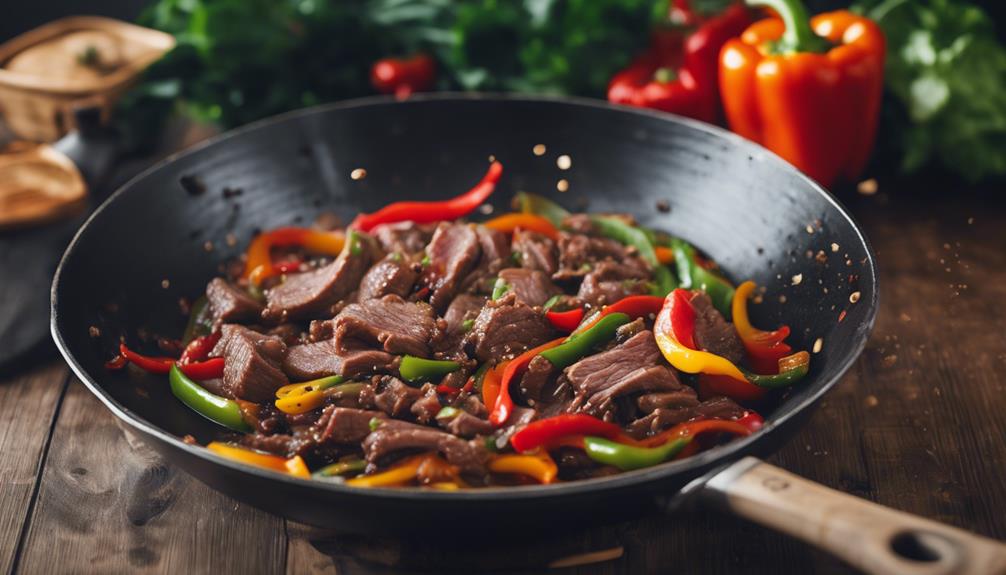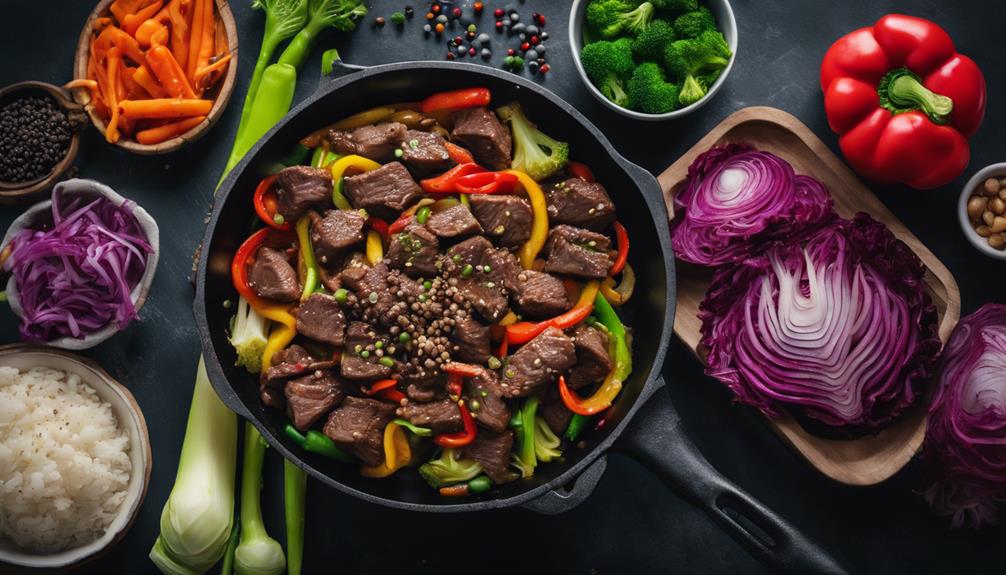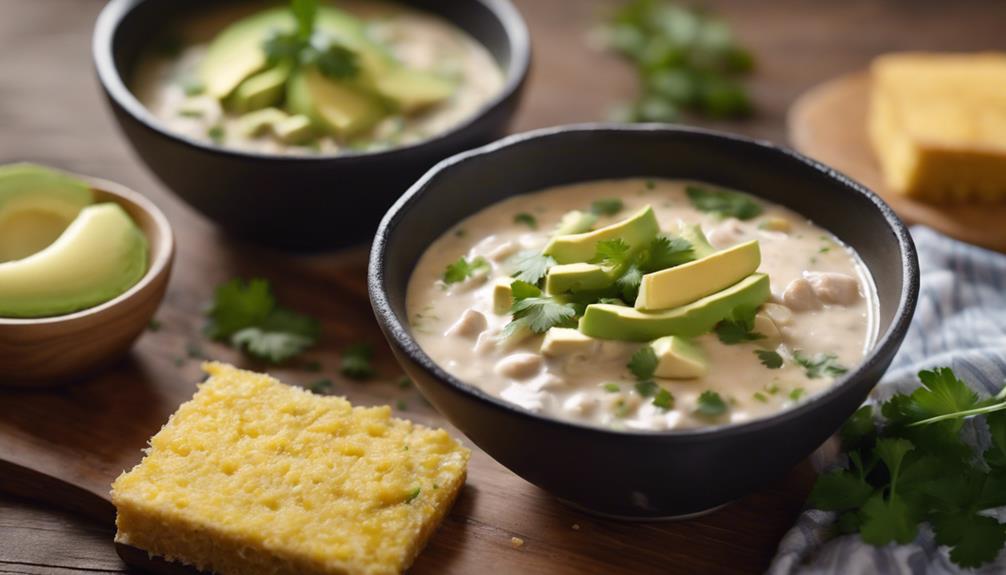Indulge in a delicious Black Pepper Beef and Cabbage Stir Fry, a quick dinner packed with flavorful taste. Prepare ground beef with a dash of salt for added richness. Sauté garlic and cabbage until tender, then add black pepper for a bold flavor. Mix soy sauce and cornstarch for a tasty sauce base. Add extra veggies for a healthy twist. Serve with jasmine or brown rice for a satisfying meal. Store any leftovers in the fridge and reheat with a splash of water or soy sauce. Explore more about the enticing flavors and serving ideas for this delectable dish.
Key Takeaways
- Utilize ground beef, cabbage, garlic, black pepper, and soy sauce for a flavorful stir fry.
- Customize spice level and add extra veggies for a nutritious and delicious meal.
- Store leftovers properly in the fridge and reheat with a splash of water or soy sauce.
- Pair with jasmine rice, quinoa, or stir-fried veggies for a complete and satisfying dinner.
- Enjoy a quick and tasty meal that's simple to make and perfect for groups.
Ingredients for Black Pepper Beef Stir Fry
To prepare the Black Pepper Beef Stir Fry, gather ground beef, cabbage, garlic, black pepper, and soy sauce as your key ingredients. Begin by slicing the cabbage into thin strips and mincing the garlic finely.
In a small bowl, mix cornstarch with soy sauce until smooth, creating a flavorful sauce base for your stir fry. Heat a skillet over medium-high heat and add a drizzle of oil. Once the skillet is hot, add the ground beef and stir continuously until it's browned and cooked through.
Next, introduce the cabbage and garlic to the skillet, stirring them along with the beef. The aroma of garlic and the sizzle of the cabbage will fill your kitchen, indicating that the vegetables are cooking perfectly. Sprinkle a generous amount of black pepper over the mixture, infusing it with a bold and aromatic flavor.
Preparing the Ground Beef

When preparing the ground beef for your Black Pepper Beef and Cabbage Stir Fry, focus on browning it evenly to enhance its rich flavor and texture. Start by heating a large skillet over medium-high heat. Add the ground beef and sprinkle a pinch of salt to season it. Cook the ground beef, breaking it into smaller pieces with a spatula, until it's fully browned.
Once cooked, use a spoon to drain excess fat from the skillet. This step helps reduce the greasiness of the dish, making it lighter and more enjoyable.
Ground beef has the ability to absorb the flavors of the seasonings and sauces you add to your stir fry. Consider incorporating soy sauce or other seasonings to enhance the overall taste of the dish. Cooking the ground beef thoroughly is important not only for flavor but also for food safety.
Make sure the beef is fully cooked before moving on to the next steps in your Stir Fry recipe.
Sautéing the Garlic and Cabbage

Once the ground beef is browned and drained, proceed to sauté the garlic and cabbage to infuse the stir fry with aromatic flavors and textures. Sautéing the garlic releases its pungent aroma, creating a fragrant base for the dish.
The cabbage, when cooked just right, maintains a delightful crunch while soaking up the flavors of the garlic and beef. This process allows the natural sweetness of the cabbage to meld harmoniously with the savory notes of the beef, resulting in a well-balanced stir fry.
- The sizzle of garlic hitting the hot pan fills the air with a tantalizing scent.
- The cabbage begins to wilt slightly, softening but still retaining its vibrant green color.
- As the garlic turns golden brown, its sharpness mellows out, blending seamlessly with the cabbage.
- The flavors of the sautéed garlic and cabbage start to mingle, promising a delicious and satisfying stir fry experience.
Adding Black Pepper and Soy Sauce

When adding black pepper and soy sauce to your beef and cabbage stir fry, you're elevating the dish's flavors to new heights.
The black pepper introduces a spicy element that tantalizes your taste buds, while the soy sauce brings a rich umami essence that enhances the overall savoriness of the meal.
Together, these two ingredients work harmoniously to create a delectably seasoned stir fry that will leave you craving more with every bite.
Flavor Enhancement With Pepper
For enhancing the flavors of your Black Pepper Beef and Cabbage Stir Fry, incorporate a generous amount of black pepper and soy sauce to create a robust and savory sauce. When adding these key ingredients, imagine the following sensory experience:
- Sprinkling a liberal amount of freshly cracked black pepper over the sizzling beef, releasing its bold and spicy aroma.
- Drizzling soy sauce over the stir fry, watching it sizzle and infuse the dish with its savory and umami-rich essence.
- Observing the black pepper and soy sauce melding together, creating a harmonious balance that enhances the overall taste profile of the dish.
- Tasting the peppery kick from the black pepper as it complements the richness of the beef, while the soy sauce adds depth and complexity to every bite.
Soy Sauce for Umami
To enhance the umami flavors of your Black Pepper Beef and Cabbage Stir Fry, incorporate soy sauce generously along with a liberal amount of black pepper. Soy sauce is a fundamental component in stir-fry dishes, known for adding depth and richness to the overall flavor profile.
When combined with black pepper, soy sauce creates a savory balance that elevates the taste experience of the dish. The umami notes in soy sauce complement the ingredients in the stir fry, ensuring a well-rounded and satisfying outcome.
Incorporating soy sauce not only enhances the flavor but also helps to balance out the spiciness of the black pepper and the richness of the beef. This combination of soy sauce and black pepper is a classic pairing in Asian cuisine, known for creating a bold and harmonious blend of tastes.
Customizing the Stir Fry

When customizing your stir fry, consider mixing flavorful ingredient combinations to enhance the overall taste experience.
Adjust the spice level by adding more black pepper for a kick or toning it down for a milder dish.
Don't forget to pack in extra vegetables for added color, texture, and nutrition.
Flavorful Ingredient Combinations
You can elevate the flavors of the Black Pepper Beef and Cabbage Stir Fry by incorporating your preferred vegetables and protein choices. Enhance the dish with colorful bell peppers, crunchy carrots, earthy mushrooms, or any other vegetables you enjoy.
Experiment with tender chicken, succulent shrimp, or protein-packed tofu to add variety and depth to your stir fry. Adjust the level of black pepper to your liking, whether you prefer a subtle hint of spice or a bolder flavor profile.
Try adding ginger for warmth, chili flakes for heat, or oyster sauce for a savory umami kick. For a final touch, sprinkle sesame seeds for a nutty crunch and garnish with freshly chopped scallions to add a pop of freshness to your dish.
Adjusting Spice Level
Curious how to tailor the spice level of your Black Pepper Beef and Cabbage Stir Fry to your liking? Adjusting the heat in your stir fry can be easily achieved by manipulating the amount of black pepper used. Whether you prefer a milder dish or enjoy a fiery kick, the black pepper quantity can be increased or decreased according to your personal preference for spiciness.
To further customize the flavor profile, experimenting with different types of peppercorns or pepper blends can offer a unique twist to your dish.
For those seeking an extra punch of heat, consider incorporating chili flakes or fresh chili peppers into the stir fry. These additions not only intensify the spiciness but also contribute a depth of flavor that complements the black pepper.
Remember to taste the stir fry as you cook and make adjustments to the amount of pepper to suit your taste buds perfectly. By following these simple tips, you can create a Black Pepper Beef and Cabbage Stir Fry that's tailored to your desired spice level.
Adding Extra Vegetables
To enhance the flavor and nutrition of your Black Pepper Beef and Cabbage Stir Fry, consider adding extra vegetables such as carrots, mushrooms, broccoli, or snow peas.
Experiment with vegetables like bell peppers, snap peas, or water chestnuts to vary the texture and crunch in your stir fry.
Enhance the nutritional value of your dish by adding a colorful mix of vegetables, contributing to its visual appeal.
Customize your stir fry by swapping or adding vegetables based on your preferences or what you have on hand.
Varying vegetable combinations not only add depth to the flavors but also make the dish more well-balanced and versatile.
Serving Suggestions for Dinner

Consider pairing this Black Pepper Beef and Cabbage Stir Fry with hot steamed rice for a satisfying dinner experience.
To prepare this dish, start by heating a large skillet over medium-high heat and adding the beef until it browns. Stir-fry until the beef is cooked through, then add the cabbage and continue cooking until it's slightly wilted.
Season the stir fry with soy sauce and adjust the seasoning with salt and pepper to taste. Once ready, top the dish with toasted sesame seeds and scallions for added flavor and texture.
This dish not only offers a delicious blend of flavors but also provides a wholesome meal option that can serve a group of people. If you enjoy the Black Pepper Beef and Cabbage Stir Fry, consider saving this recipe for future dinners.
Enjoy this simple and tasty stir-fry either on its own or paired with your favorite side dishes for a complete and satisfying meal.
Storing Leftover Stir Fry

When storing leftover Black Pepper Beef and Cabbage Stir Fry, make sure it has cooled to room temperature before refrigerating in an airtight container for up to 4 days.
Here are some tips for storing your delicious stir fry:
- Seal the cooled stir fry in an airtight container to lock in flavors and prevent odors from affecting the dish.
- Place the container in the refrigerator to maintain freshness and prevent bacterial growth.
- When ready to enjoy again, reheat the stir fry in a skillet or microwave until it's heated through.
- Consider adding a bit of water or extra soy sauce while reheating to keep the dish moist and flavorful.
Pairing Options for Side Dishes

Enhance your Black Pepper Beef and Cabbage Stir Fry with a variety of delicious side dish options. To complement the flavors of the beef and cabbage stir fry, consider serving it with steamed jasmine rice for a classic and satisfying pairing.
For a healthier choice, opt for brown rice or quinoa to add fiber and nutrients to your meal. If you prefer a low-carb alternative, cauliflower rice or zucchini noodles can be excellent options to accompany the stir fry.
Create a well-rounded meal by including a side of stir-fried vegetables like broccoli, bell peppers, or snap peas to add color and freshness to your plate. To elevate the dish further, pair it with a invigorating cucumber salad or a light Asian slaw for a burst of contrasting flavors.
Experiment with different combinations to find the perfect side dish that complements the bold and peppery notes of the Black Pepper Beef and Cabbage Stir Fry.
Frequently Asked Questions
How to Make Beef Super Tender for Stir-Fry?
To make beef super tender for stir-fry, marinate thinly sliced beef in a mixture of soy sauce, cornstarch, and a bit of oil for at least 15-30 minutes. Slice against the grain for tenderness and cook quickly over high heat.
How to Cook Stir-Fry Beef Without Overcooking?
To cook stir-fry beef without overcooking, sear it briefly on high heat, slice it thinly for tenderness, and toss it constantly in the pan. Remove it promptly and let it rest before serving to keep it juicy and flavorful.
Why Is Napa Cabbage Good for Stir Frying?
Napa cabbage is perfect for stir-frying because of its crunchy texture, mild flavor, and ability to absorb flavors well. It's rich in vitamins A and C, adding nutrition to dishes, and its high water content creates juicy stir-frys.
Can You Add Black Pepper to Stew?
You can definitely add black pepper to stew! It enhances the flavor and adds a subtle heat. Adjust the amount based on your preference. Black pepper is versatile and complements both meat-based and vegetarian stews for added depth.
Can Roasted Garlic Brown Butter Mashed Potatoes be Paired with Black Pepper Beef and Cabbage Stir Fry for Dinner?
Absolutely! This roasted garlic mashed potatoes recipe will make a perfect pairing with black pepper beef and cabbage stir fry for dinner. The creamy and flavorful mashed potatoes complement the savory and peppery beef dish, creating a delicious and satisfying meal. It’s a winning combination that is sure to please everyone at the dinner table.
Conclusion
To sum up, black pepper beef and cabbage stir fry is a quick and tasty dinner option that can be easily customized to suit individual preferences.
By following the simple steps outlined in this article, you can create a delicious meal that's sure to satisfy your cravings.
Whether you're looking for a flavorful weeknight meal or a dish to impress your guests, this stir fry recipe is a versatile and delicious choice.
Enjoy!










